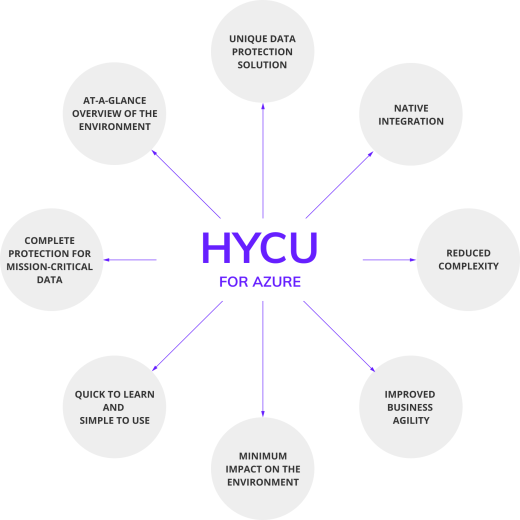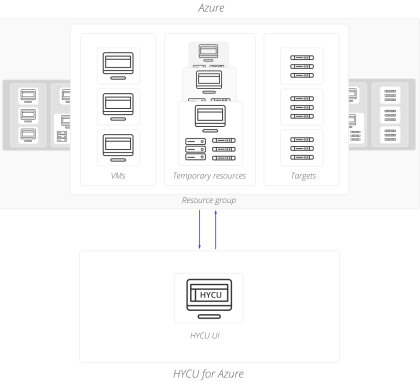About HYCU for Azure
HYCU Data Protection as a Service for Azure (HYCU for Azure) is a fully managed backup and recovery service for Microsoft Azure that is specifically designed to make data protection as simple and cost-effective as possible, to improve your business agility, and to bring unified security, reliability, performance, and user experience.

Figure: Introduction to HYCU for Azure
Key features and benefits
The following features make HYCU for Azure a solution that can transform your business—achieving complete compliance and data protection:
-
Protection against data loss
Delivers native data protection for Azure virtual machines and ensures data consistency and easy recoverability.
-
Data protection in a few minutes
Data protection for virtual machines can be enabled in a few minutes after you subscribe to HYCU for Azure, with no deployment and configuration concerns.
-
Predefined policies and options for policy customization
Simplifies implementation of data protection by providing predefined policies and includes options for policy customization that can address your special data protection needs.
-
Scheduled backups
Automatic backup scheduling provides data protection based on your recovery point objectives (RPOs).
-
Low impact on the environment
Agentless architecture reduces backup load on production virtual machines. In addition, backup windows enable you to completely avoid the impact of backup activity on your production environment during peak hours.
-
Use of data archives
When you create an archive of data, you ensure your data is isolated from your current activity and safely stored for future reference.
-
At‑a‑glance overview of the data protection environment
The HYCU for Azure dashboard helps you to identify potential problems and bottlenecks to improve the performance of your data protection environment.
-
Restore of individual files
A possibility to restore one or more files to the original or a different location on the virtual machine, or to a target is an alternative to restoring the entire virtual machine.
-
Integration with the Azure billing system
Cost of data protection is billed by Microsoft through existing subscriptions, without requiring you to provide additional billing information.
-
Business continuity of your data protection environment across different infrastructures
HYCU Protégé ensures data resilience by using the SpinUp functionality to migrate protected data between the on-premises and Azure infrastructures. In the event of a disaster in your on-premises environment, HYCU Protégé provides disaster recovery of data to cloud. For details on the supported on-premises infrastructures and how to employ HYCU Protégé, see HYCU for Enterprise Clouds documentation.
Data protection environment overview
The data protection environment consists of the following components:
| HYCU for Azure web user interface |
An interface for protecting virtual machines and managing the data protection environment. |
| Resource groups |
Containers that include resources managed as a group—virtual machines, targets, and temporary resources. |
| Targets |
Storage accounts that HYCU for Azure uses for storing backup data. Backup data can also be stored as snapshots. |
| Virtual machines |
Resources to which you can assign a policy and for which you therefore provide data protection. Data is always protected at a granular level, allowing you to restore either the entire virtual machines, individual disks, or individual files. |
| Temporary resources | Virtual machines and disks that HYCU for Azure creates automatically for data protection purposes. |
The following figure shows the data protection environment and its components:

Figure: HYCU for Azure architecture
HYCU for Azure data protection
With the HYCU for Azure data protection solution, you can be confident that your business data is protected, which means that it is backed up in a consistent state, stored to a target, and can be restored.
HYCU for Azure enables you to protect virtual machines. After you establish your data protection environment, you can enable data protection by selecting the virtual machines that you want to protect and assigning policies to them. After the backup is completed, you can restore data from such a backup.